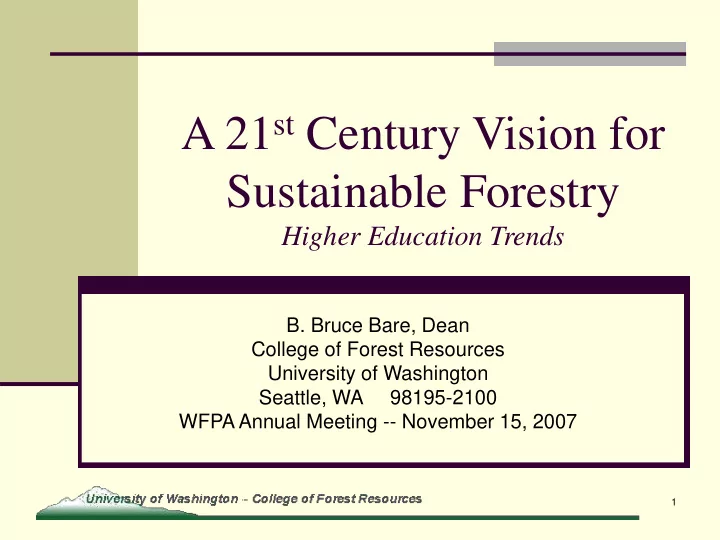

A 21 st Century Vision for Sustainable Forestry Higher Education Trends B. Bruce Bare, Dean College of Forest Resources University of Washington Seattle, WA 98195-2100 WFPA Annual Meeting -- November 15, 2007 1
Changes Effecting the Future ◼ Paradigm shift in natural resource management ◼ Professional graduate education as an outgrowth of, and linked to, undergraduate education ◼ New agenda for graduate education in 21 st Century 2
Shifting Management Philosophy ◼ 20 th Century ◼ 21 st Century ◼ Agricultural Model ◼ Ecosystem Model ◼ Utilitarian foundation ◼ Biocentric orientation ◼ Output oriented ◼ State oriented ◼ Stand level ◼ Landscape view ◼ Timber primacy ◼ Multi-resource (sustained yield) (sustainability) ◼ Multiple use ◼ Integrated use ◼ Fundamental research ◼ Integrative research 3
Why a Paradigm Shift? ◼ Changing societal values of a growing and urbanizing population ◼ Growing awareness of the ecological and environmental implications of climate change ◼ Concern over loss of biodiversity in managed forests, invasives, endangered species, wildfire, water, and forest health (insects and diseases) 4
Why a Paradigm Shift? ◼ Recognition that we live on a human dominated planet where man greatly influences ecosystems in a complex fashion over many dimensions and scales and has done so for many years ◼ Ecosystems do not attain a stable equilibrium but, instead, are open systems always in flux ◼ Both natural and man-caused disturbances play a significant role in ecosystem health 5
21 st Century Environment ◼ Reducing the risk of forest loss may replace productivity as the principal concern of managers and policy makers ◼ Increasing the resiliency of our forests so they are sustainable will grow more important ◼ Suggests that education must change to keep pace so we continue to educate the future leaders we will need 6
Changes Effecting Education ◼ Paradigm shift in natural resource management ◼ Professional graduate education as an outgrowth of, and linked to, undergraduate education ◼ New agenda for graduate education in 21 st Century 7
Forestry Higher Education ◼ Basic undergraduate education in forestry started at Yale at beginning of 20 th Century ◼ Followed the agricultural model (mensuration, fire protection, timber harvesting, economics, silviculture, soils, etc.) ◼ Heavy emphasis on technical field skills for entry- level positions ◼ Usually well structured programs (few electives) ◼ Curriculum content heavily influenced by employers and accrediting bodies 8
Forestry Higher Education ◼ Although basic undergraduate forestry education served society well during most of the 20 th Century, most forestry schools are changing their curricula to meet the new challenges of the 21 st Century 9
Forestry Higher Education ◼ Important to a 21 st Century education are: ◼ Educate as team member, problem solver, and integrator of information ◼ Stress concepts, principles, and theories over facts (social, ecological, and economic) ◼ Reduce specialization at undergraduate level ◼ Prepare students for post-graduate education (if desired) and a future of constant learning ◼ Include global perspective throughout the educational process 10
Forestry Higher Education ◼ Provide a broad science-based undergraduate education followed (possibly) by a professional Master’s education ◼ Incorporate new technologies into the curriculum ◼ Develop more distance learning professional Master’s modules for time/place bound students 11
Changes Effecting Education ◼ Paradigm shift in natural resource management ◼ Professional graduate education as an outgrowth of, and linked to, undergraduate education ◼ New agenda for education in 21 st Century 12
Future Educational Mission ◼ To discover and understand ecosystem processes, develop new approaches for the use and protection of natural resources and environmental services, and understand human behavior and decisions about natural resources Source: Don DeHayes, President, NAPFSC, 2004 13
McIntire-Stennis Strategic Plan ◼ Major components ◼ Foundation areas of knowledge ◼ Emerging and integrative areas of knowledge ◼ New science of integration ◼ Forest ecosystem services ◼ Human attitudes and behavior ◼ Conflict, uncertainty and decision-making ◼ Technology advancements and forest applications ◼ New applications for forest products ◼ Urban ecosystems Source: Sustaining Healthy and Productive Forests, NAUFRP, 2007 14
Emerging Areas ◼ Landscape analysis ◼ Spatial analysis and information management ◼ Watershed science and planning ◼ Forest ecosystem health and restoration ◼ Risk analysis (ecological and economic components) ◼ Bio-resources science and engineering Source: National Graduate Education Needs and Priorities, NAPFSC, 2003 15
Education in 21 st Century ◼ Integrate social and ecological issues holistically ◼ Maintain disciplinary depth while also providing a greater breadth ◼ Understand how to accept rapid change in an uncertain world ◼ Collaborate in an interdisciplinary environment ◼ Support development of a new science of sustainability to integrate ecological and economic approaches in a socially acceptable manner 16
The End 17
Recommend
More recommend